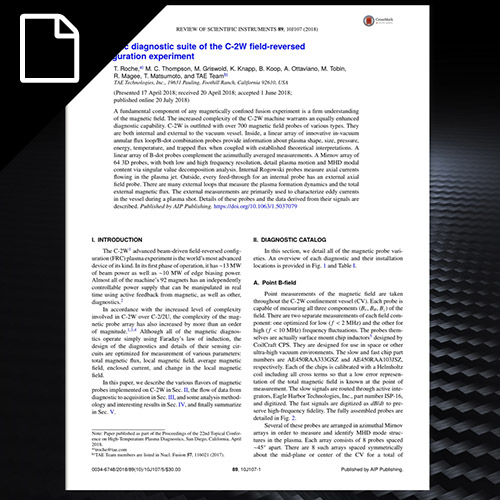
Oct 2018 | Research Library, Papers, Experiment, Formation, Fusion Energy, Fusion Research, Fusion Science, Fusion Technology, Plasma Research, Simulation
July 2018 | F. Tanaka (Nihon Univ.) | Plasma and Fusion Research | Paper
In order to investigate the collisional merging process of field-reversed configurations (FRCs), the FAT device has recently been upgraded to FAT-CM, consisting of two field-reversed theta-pinch (FRTP) formation sections and the confinement section.

Oct 2018 | Research Library, Papers, Diagnostics, Experiment, Fusion Energy, Fusion Research, Fusion Science, Fusion Technology, Plasma Research
August 2018 | A. DuBois | Review of Scientific Instruments | Paper
A custom motor controlled probe system has been designed to make spatially resolved measurements of temperature, density, flow, and plasma potential in the C-2W inner divertors.

Oct 2018 | Research Library, Papers, Diagnostics, Experiment, Fusion Energy, Fusion Research, Fusion Science, Fusion Technology, Plasma Research
August 2018 | H. Gota | Review of Scientific Instruments | Paper
Field-reversed configuration (FRC) Amplification via Translation–Collisional Merging (FAT-CM) experiments have recently commenced to study physics phenomena of colliding and merged FRC plasma states.

Oct 2018 | Research Library, Papers, Diagnostics, Experiment, Fusion Energy, Fusion Research, Fusion Science, Fusion Technology, Plasma Research
August 2018 | E. M. Granstedt | Review of Scientific Instruments | Paper
Two filtered, fast-imaging instruments, with radial and axial views, respectively, were used on the C-2U device to visualize line emission from impurities and hydrogenic neutrals.

Oct 2018 | Research Library, Papers, Diagnostics, Experiment, Fusion Energy, Fusion Research, Fusion Science, Fusion Technology, Plasma Research
July 2018 | T. Roche | Review of Scientific Instruments | Paper
A fundamental component of any magnetically confined fusion experiment is a firm understanding of the magnetic field. The increased complexity of the C-2W machine warrants an equally enhanced diagnostic capability.




